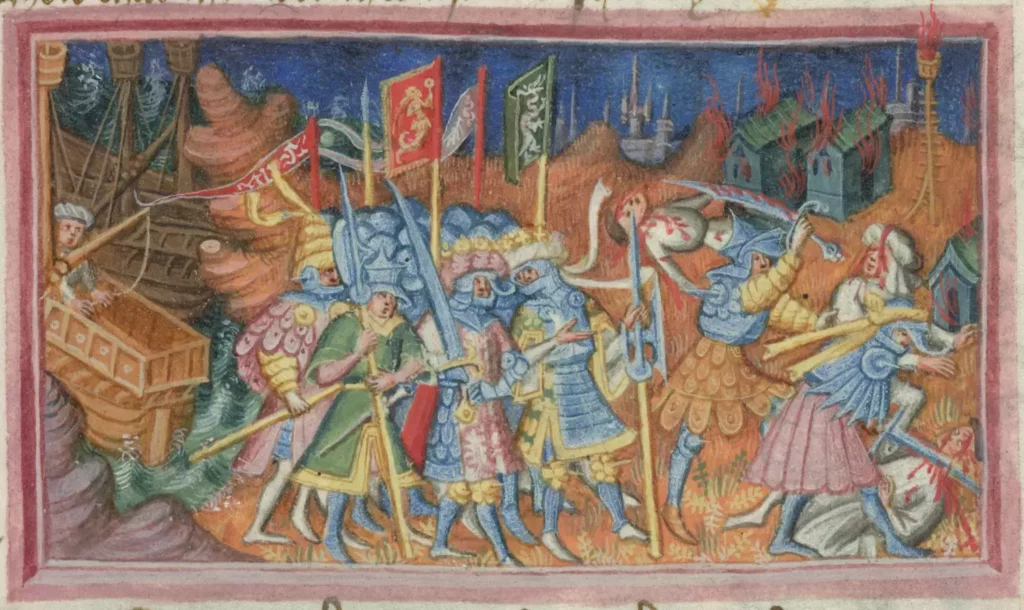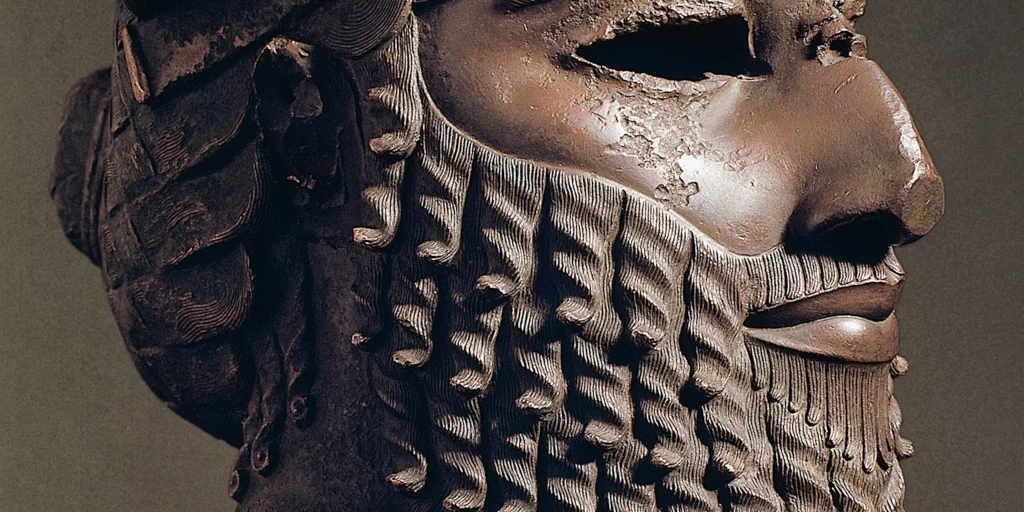Last updated on March 8th, 2023 at 05:50 am
Vikings are often depicted as brutal warriors, striking fear into the hearts of all who dare stand in their way. Many impressive figures illuminate the pages of their rich history.
Amongst them, Ivar the Boneless, a legendary figure in Viking lore, was a warrior of especially unmatched ferocity and cunning. His name alone conjures images of brutal battles and ruthless conquests, and he secured a place in history like few others over his lifetime.
His legacy as one of the most feared Viking warriors lives on even today, his name continuing to inspire awe and reverence centuries after his death, a testament to the indomitable spirit of the Vikings.

The Son of Ragnar Lothbrok
According to legend, Ivar the Boneless was the son of the famous Ragnar Lothbrok (also written Ragnar Lodbrok). Ragnar, a 9th-century Danish king, is remembered by history and legend as a larger-than-life personality.
Responsible for numerous campaigns and conquests, Ragnar Lothbrok and his kingdom flourished throughout the 800s AD, even battling the Holy Roman Emperor, King Charlemagne, himself.
However, Danish historian Saxo Grammaticus recounts the story of his eventual, unpleasant demise. No king can live forever, and Ragnar was no different – in a fateful battle, the legendary Danish king was captured by King Ælla of Northumbria, a kingdom of medieval England, and unceremoniously thrown into a pit of venomous snakes to die.
Before his untimely death, Ragnar Lothbrok left three sons, who legend prophesied would one day avenge him – Halfdan, Ubbe, and the infamous Ivar Ragnarsson.
The Early Life of Ivar the Boneless
Ivar the Boneless is a storied, almost mythical, figure in Viking lore and history. This presents a challenge, as his tale only crops up in a few sources, and differing stories abound.
However, we know for sure that Ivar was an important individual. His story appears in the Anglo-Saxon Chronicle, the Annals of Ulster, the Icelandic Sagas, and more.
Confusingly, Ivar is likely also identical to the historical figure Ímar, the Viking king of the Uí Ímair dynasty. Despite the discrepancies, we are able to paint a historically accurate picture of Ivar the Boneless.
Ivar Ragnarsson was born the son of Ragnar Lothbrok and his wife Aslaug, likely sometime around 800 AD. The Tale of Ragnar Lodbrok tells us that Ivar grew so large and so fierce none were his equal.
From a young age, it was clear he was destined to be an important Viking warlord and make his mark on history. However, Ivar is known today not only for his conquests but also for the unique name he receives.
Why Was Ivar Called the ‘Boneless’?
Ivar the ‘Boneless’ was a compelling, unique nickname that raises more questions than it can hope to answer. The name comes to us from the tale of Ivar’s birth.
The legendary tale says that Ivar’s mother, Aslaug, was aware of a curse upon them and warned Ragnar they needed to delay three nights to consummate their marriage.
The king failed to heed her warning. In turn, the curse caused their son, Ivar, to be born ‘boneless.’
It is here that the histories and sagas differ in their details. Some claim Ivar was born with weak bones, others that he lacked bones or even legs altogether. Some, like Saxo Grammaticus, fail to mention any disability at all.
If true, Ivar’s condition would likely have been a hereditary skeletal condition. One possibility is osteogenesis imperfecta, also known as brittle bone disease, which would have constituted a serious disability.
Other modern scholars, however, theorize the name could be the result of a translation error. For example, early translations could have mistaken ‘Exos’ or ‘Boneless’ for ‘Exosus,’ which would translate to ‘Hated.’
Either way and surely, despite any disability, Ivar the Boneless was a cunning and savage warrior if the legend is to be our guide.
The Tale of Ragnar’s Sons
After Ragnar died in the snake pit in Northumbria, Ivar sought conquest and bloody revenge.
The savage and brutal death of their father quickly united Ragnar’s sons, Ivar chief among them, to avenge him. All accounts point to the Ragnarssons being great and terrifying Vikings of unbelievable strength and ferocity.
Together, Ivar, along with his brothers, gathered a large force of Vikings, a great army of enormous proportions, and decided to set sail for England. Ivar led the Viking campaign to hitherto unseen heights of conquest and destruction, unlike previous Viking raiders.
The Anglo-Saxon Chronicle
The Anglo-Saxon Chronicle tells us of the Great Heathen Army, led by Ivar, invading Anglo-Saxon England in 865 AD. During this period, Medieval England was a collection of smaller kingdoms.
The Viking invasion of the British Isles, and their combined wrath, began in East Anglia. However, not much is known about this initial period of fighting.
It’s possible that Ivar and his brothers even faced defeat in East Anglia and failed to exact the revenge they sought on King Ælla. In his shrewdness, Ivar apparently went to Ælla then, seeking peace and the chance to bide his time until he could properly wage war.
The Defeat of Northumbria
Just a few years later, in 867, Ivar and his Great Heathen Army returned to Northumbria. This time, his forces proved victorious, and, at York, Ælla was captured.
In old Viking sagas, the warriors are often portrayed as bloodthirsty, ravenous, and displaying a sort of love lust for death and destruction. Legendary tales of their revenge on Ælla only further bolster this case.
Ivar is said to have executed the Anglo-Saxon king by performing the “blood eagle,” a horrible, nasty ritual by which the ribcage of the victim is torn open from behind, the lungs taken out, and salted. The victim’s lungs are said to resemble “blood-stained wings,” giving the awful ritual its name.
Not one to be satiated, Ivar continued his conquest, heading south and leaving only terror and ruin in his wake.
Ivar, the Viking King
After installing a puppet ruler in Northumbria, Ivar, and his enormous army moved south to East Anglia. First, he besieged Nottingham in the kingdom of Mercia.
Ivar the Boneless and his Viking horde would spend the winter there before resuming their pillaging in the springtime. However, the Mercian king, Burgred, fought back mightily.
Forming an alliance with the king of Wessex, Æthelred, and his heir, the soon-to-be King Alfred, the two kingdoms outnumbered their common enemy.
Ivar realized his position and agreed to a truce – the Treaty of Nottingham – and retreated the Vikings back to York. Though, he would not stay for long.
In 870, Ivar and his brothers returned, defeated Mercia, and conquered East Anglia with his brothers Halfdan and Ubba. Legend has it Ivar himself, a fearsome warrior in his own right, executed King Edmund at Hoxne.
Additional conquest and battles in Wessex would leave England almost entirely controlled by the Vikings by 870 AD.
Across the Irish Sea to Dublin
If the connection between Ivar and Ímar is correct, Ivar continued his reign of conquest and glory across the Irish Sea.
The Vikings had already been fighting, raiding, and pillaging Scotland to the north, and Ireland to the west, for decades. In fact, Irish sagas depict Ivar leading battles in Dublin as early as the 850s AD, where he made headquarters for his Irish conquests.
After subduing much of England in 870 AD, it is believed that Ivar traveled north to Scotland and met with his Irish co-ruler, Olaf the White. The two Irish rulers would lead another large Viking force and lay siege upon Dumbarton Rock, capturing the decades-long hold-out.
After he destroyed Dumbarton, Ivar, and his fellow Vikings returned to Dublin. This, as fate would have it, is the last we hear of Ivar in the pages of Viking lore.
The Death of Ivar the Boneless
We know little of Ivar’s eventual end. English chronicles tell us he died in 870, while the Annals of Ireland claim he perished in 873 in Dublin of a sudden and horrible disease.
Whether it was from an unidentified disease or from being struck down in battle, the cunning, infamous warrior died not long after the legendary conquests that we know him for.
The location of his death is also a mystery. However, modern discoveries may give us some clues. For instance, in the late 17th century, in Derbyshire, England, a farmhand named Thomas Walker uncovered a Scandivanian gravesite.
Some scholars suggest, due to its particular location and the number of bones and skeletons scattered around the buried man, this could be the final resting place of Ivar the Boneless.
Whether the burial was Ivar’s or not, his memory lives on in Old Norse lore and legend. Few other Vikings – and few other individuals, anywhere – can compare to his storied place in history.
References
Groeneveld, Emma. “Ivar the Boneless.” World History Encyclopedia, 8 Feb. 2023, https://www.worldhistory.org/Ivar_the_Boneless/.
Holman, Katherine. The Northern Conquest Vikings in Britain and Ireland. Andrews, 2012.
“Ivar the Boneless.” Ivar the Boneless | Viking Berserker, https://www.englishmonarchs.co.uk/vikings_10.html.
Jones, Thomas Gwyn. A History of the Vikings. Oxford University Press, 1986.
Kessler, P L. “Anglo-Saxon Britain.” The History Files, https://www.historyfiles.co.uk/FeaturesBritain/EnglandIvarr.htm.

